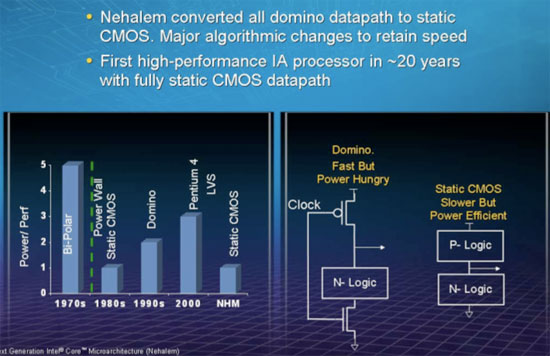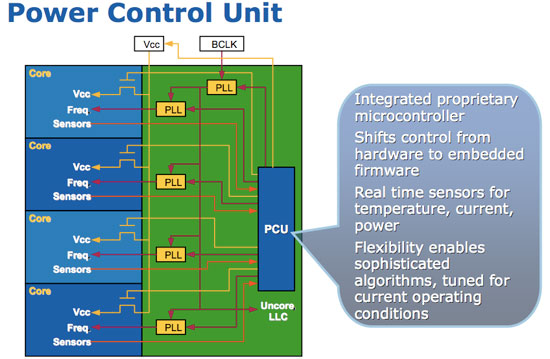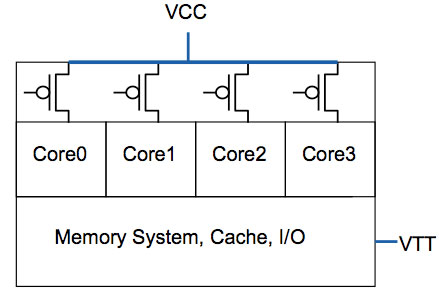Nehalem - Everything You Need to Know about Intel's New Architecture
by Anand Lal Shimpi on November 3, 2008 1:00 PM EST- Posted in
- CPUs
New Stuff: Power Management
At this year’s IDF the biggest Nehalem disclosures had to do with power management.
Nehalem’s design was actually changed on a fairly fundamental level compared to previous microprocessors. Dynamic domino logic was used extensively in microprocessors like the Pentium 4 and IBM’s Cell processor in order to drive clock speeds up. With Nehalem, Intel has removed all domino logic and moved back to an entirely static CMOS design.

Nehalem’s architects spent over 1 million transistors on including a microcontroller on-die called the Power Control Unit (PCU). That’s around the transistor budget of Intel’s 486 microprocessor, just spent on managing power. The PCU has its own embedded firmware and takes inputs on temperature, current, power and OS requests.

Each Nehalem core gets its own PLL, so each core can be clocked independently - much like AMD’s Phenom processor. Also like Phenom, each core runs off of the same core voltage - the difference between Nehalem and Phenom however is Intel’s use of integrated power gates.
Through close cooperation between Nehalem’s architects and Intel’s manufacturing engineers, Intel managed to manufacture a very particular material that could act as a power gate between the voltage source being fed to a core, and the core itself.


The benefit is that while still using a single power plane/core voltage, individual Nehalem cores can be completely (nearly) shut off when they are in deep sleep states. Currently in a multi-core CPU (AMD or Intel), all cores need to run at the same voltage, which means that leakage power on idle cores is still high just because there’s one or more active cores in the CPU.
Nehalem’s power gates allow one or more cores to be operating in an active state at a nominal voltage, while remaining idle cores can have power completely shut off to them - without resorting to multiple power planes, which would drive up motherboard costs and complexity.
The other benefit of doing this power management on-die is that the voltage ramp up/down time is significantly faster than conventional, off-die, methods. Fast voltage switching allows for more efficient power management.
I mentioned earlier that the PCU monitors OS performance state requests, so it can actually make intelligent decisions about what power/performance state to go into, despite what the OS is telling it. There are some situations where Vista (or any other OS) running an application with a high level of interrupts will keep telling the CPU to go into a low power idle state, only to wake it up very shortly thereafter. Nehalem’s PCU can monitor for these sorts of situations and attempt to more intelligently decide what power/performance states it will instruct the CPU to go into, regardless of what the OS thinks it wants.










35 Comments
View All Comments
qurious69ss - Friday, August 22, 2008 - link
You sound like one of those sad fanboys from amdzone. Tell dimentia to get a life.X1REME - Friday, August 22, 2008 - link
wow, this whole cpu is a copy of a amd cpu and you expect amd fan boys to not get amd with you, secondly this fantasy is baseless until you can compare it to an offering from the AMD team (Shanghai & Deneb). AMD is still KING with there OPTERON and most likely will be in the future with there new cpu coming soon for the server and also for the desktop.DigitalFreak - Friday, August 22, 2008 - link
Learn to spell, you goober.X1REME - Friday, August 22, 2008 - link
OK DORK, am sure you have never made a mistake (there=their) Duh. I bet your some kid all hyped up for the i7 who wishes Xmas comes early lol. Anyway it’s not a desktop chip, it’s a sever chip DUH. It’s meant to compete with the AMD Opteron chip (the best). Although Opteron will lose its crown, it won’t be to i7 but to Shanghai (AMD new latest and greatest). And like I said b4, Deneb will clear anything up out of place.The reason amd does not grab a microphone and star shouting at the top of their voice is because amd doesn't have the resources and money in comparison with Intel. If it reveals too much about its future strategy and Intel likes that strategy (like the Opteron, HT, On-board mem etc) there is a big theoretical chance that Intel could take this idea and deliver a product well before AMD. So it’s not over until amd says its.
snakeoil - Thursday, August 21, 2008 - link
nehalem fails,it was supposed to be superior to core 2, intel was against the wall this time, why?, because, the old front bus architecture was lagging more more in the server arena and becoming a bottleneck ,compared to hypertransport, so intel is forced to abandon the front side bus, but the strong point of core 2 is that because you don't have and integrated memory controller you can stuff the processor with a huge L2 cache.so, nehalem sucks in gaming,there is no way that the enthusiast is going to pay more for a processor that produce less fps that they actually have.
and the hyperthreading is a risky move, hypertrheading is known por being power hungry, and although produce gains in some applications,some servers applications actually runs slower, so in many cases the old hyperthreading had to be disabled.
nehalem is crippled for the enthusiast,and the regular user.
nuff said.
AssBall - Saturday, August 23, 2008 - link
You musta missed where Anand says several times its not intended for better gaming? It will be significantly faster than Penryn for multithreaded applications. I guess I don't see how this makes it "fail". Maybe in your fantasy world where 90% of the CPU market are "enthusiasts".snakeoil - Saturday, August 23, 2008 - link
enthusiasts drive the market you fruityassUnlimitedInternets36 - Saturday, August 23, 2008 - link
LOL this year Satan err Santa is going to take away your PC because you don't deserve to have one anymore You Jaded nerd.Gasaraki88 - Friday, August 22, 2008 - link
Thanks! I never knew there was a expert on CPU design in the house. I've learn so much from your well researched, tested and thought out comment...pool1892 - Friday, August 22, 2008 - link
first of all the enthusiast market is a very tiny niche, it would not kill intel if you were right.but you are not. the L2 of penryn (and banias) is much more like the nehalem L3 than the nehalem L2. and if you have a single threaded game it now has 8mb at similar latencies, but with a second buffer, the 256k L2, and a MUCH smaller cache miss penalty.
concerning hyperthreading: please read the article first. nehalem switches off what it does not need, powerwise. and about fiftytwo other very vaild arguments.